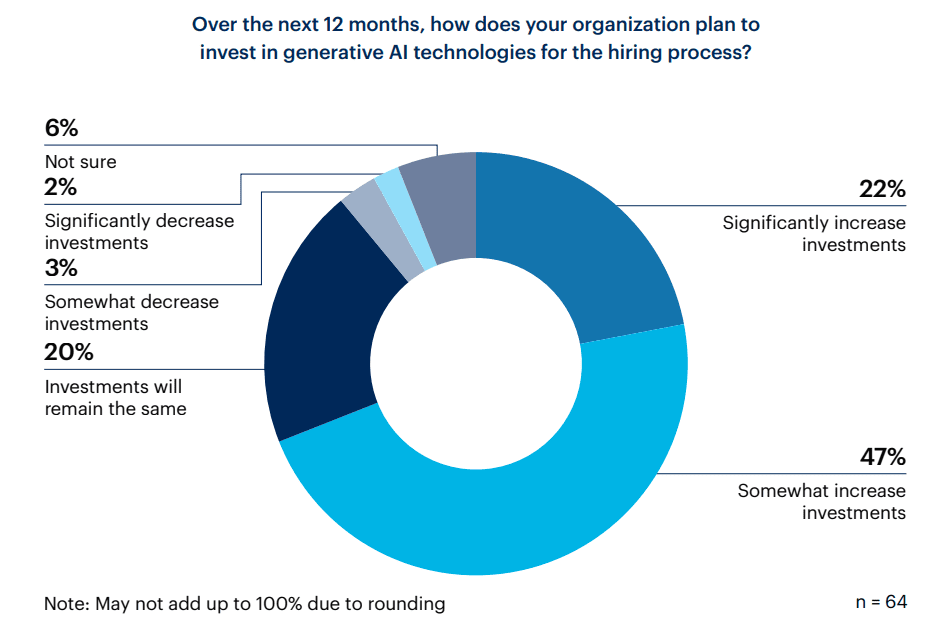
// Recruitment Technology
How to Redefine Passive Candidate Sourcing with AI
23/02/2024
9 MIN




LinkedIn’s Talent Solutions – Hiring Statistics
// Feedback
70% of the global workforce consists of individuals who are not actively looking for jobs. And 87% of both active and passive candidates are open to new opportunities.
Passive candidate sourcing, especially for C-level positions, can be an elusive game and challenging in the world of executive search. These professionals are not actively seeking new opportunities, making it difficult to identify them.
What is your approach to sourcing passive candidates? Are they easy to locate and connect with?
If you are an executive search consultant looking for ways to simplify your process of finding passive candidates, using AI tools can truly be a game-changer. Advanced AI tools such as a AI recruitment platform can streamline your entire recruitment life cycle of sourcing, engaging, qualifying, and converting passive candidates.
In this article, we will explore how you can maximise the potential of AI recruitment tools. But before we do that, let us understand who are passive candidates and the distinction between active and passive candidates.
If you’re curious to witness how AI can revolutionise your sourcing strategies, give it a try!
Who are Passive Candidates?
Passive candidates are executives who are not actively searching for a new job but may be open to exploring new opportunities. These individuals possess valuable skills and extensive experience, making them excellent potential hires.
Passive candidate sourcing goes beyond simply locating them. It involves extensive screening and initiating meaningful conversations. It requires a strategic approach that involves conducting thorough research, implementing effective engagement, and utilising different tools and platforms.





Keep in mind that passive candidates may not have a resume readily available to share.
// Feedback
In order to understand their background, it would be best to find an alternative approach and skip the usual application process.
Remember, you initiated contact with them because you saw something in them that aligns with the profile you are looking for.
When you connect with them, be sure to mention what caught your attention.
Know the Difference: Active vs Passive Candidates
Active Candidates
In simple terms, active candidates are individuals who are actively seeking employment and are taking proactive steps to find their next job.
They may not be unemployed but are actively exploring new opportunities for various reasons, including:
Seeking professional growth and advancement
Experiencing a potential layoff or job outsourcing
Growing concerns about the stability of their current employer
They constantly browse job boards, send out resumes, and reach out to recruiters.
Passive Candidates
Passive candidates are skilled individuals who are not actively searching for a new job and are usually not employed.
These candidates typically have in-demand skills and experience.
They have a proven track record and can bring their expertise to a new role, making them highly attractive to employers.
Generally, they are content with their current positions but remain open to new opportunities that offer growth prospects, leadership roles, or higher compensation.
They may be less responsive than active candidates, especially if they do not find your proposition compelling enough.
“Tiptoe” Candidates
This category of professionals known as “tiptoers” fall in the spectrum between active and passive candidates.
These individuals are not actively seeking job opportunities, but they discreetly explore possibilities by reaching out to their network.
If you reach out to these “tiptoeing candidates” early on, you can gain a significant advantage since they heavily rely on their connections.
Super Passive Candidates
This group of candidates are typically not employed and have no interest in searching for new job opportunities. Even though they might be highly qualified for your position, it could be challenging to persuade them since they are content with their current situation.
It can be quite a challenge connecting with passive candidates, especially when they are content and well-paid in their current positions. You might question “What are the advantages of passive sourcing?” and “Is sourcing passive candidates worth my time and effort?”
It is worthwhile because passive candidates are not actively seeking new opportunities, which gives you the advantage as they are less likely to be interviewing with other companies. But, how do you source passive candidates? Let’s take a look at some of the passive candidate sourcing techniques.
Passive Candidate Sourcing Techniques
Passive candidates are not actively searching or applying for positions on job boards and require a different approach to sourcing. Traditional methods like posting job ads would not be effective. Instead, you can try alternative proactive sourcing methods such as:
Connecting with contacts in their network and asking for referrals.
Searching for appealing profiles on LinkedIn, other social media platforms, and professional communities using Boolean search.
Analysing candidate data from social media activity to resume details.
Hyper-personalising your multi-channel outreach approach.
Investing in AI recruitment tools.
The entire sourcing process can be time-consuming and demanding. That’s why modern recruiters are leveraging innovative technology like AI tools to automate low-value, manual sourcing tasks.
AI tools can help you prioritise passive candidates who are the best fit for your job roles and are more likely to consider a switch.
How a AI Recruitment Platform Can Elevate Passive Candidate Sourcing
A popular question in the recruitment industry is: “Do the benefits of AI in the hiring process outweigh the risks?”
Based on insights from Gartner’s Peer Community, most of the HR professionals whose organisations utilise AI in the hiring process do believe that the benefits outweigh the risks.
22% of respondents anticipate a significant increase in investments for AI in their hiring process within the next 12 months.
63% of professionals are currently utilising AI to interact with candidates through various means such as chatbots, recruiter bots, and interview bots.

If you are a modern recruiter, it is definitely worth having AI tools in your toolkit. It can supplement your candidate sourcing strategies, reduce your effort, and have a huge payoff.
These tools can help you to monitor online signals to source passive candidates, manage your candidate pipelines, and monitor inbound communication to optimise your multi-channel outreach campaigns and maximise response rates.
For your passive candidate sourcing strategy, a AI recruitment platform can help you:
Find candidate information within seconds
One of the key features of AI is its ability to source data from various sources like social media, resumes, online portfolios, and professional networks.
Instead of spending hours searching for information, you can use AI-powered tools to obtain the same research in a matter of seconds. Moreover, it can also organise the data, thereby reducing your effort and making it easier to find the right candidate.
Analyse patterns and signals
As an executive search consultant, you may have to look beyond a candidate’s work experience and technical qualifications.
This is especially true for leadership positions, where factors like the candidate’s working style, social skills, and compatibility with the company’s culture play a significant role. These aspects greatly impact the candidate’s suitability for the role. Gathering this information may take time and require personal observation, making it a sensitive aspect of your job.
AI-powered passive candidate sourcing is becoming increasingly popular as a dependable way to gather behavioural data and conduct interpersonal research.
Just like executive search consultants, AI algorithms can provide in-depth insights into behavioural “soft” factors such as candidates’ workplace values and learning styles.
The best part is that AI tools can analyse this data quickly and impartially, making it possible to evaluate every open position efficiently. Additionally, they can even generate an overall compatibility score for each candidate.
Find top talent faster
The main objective of executive search consultants is finding the perfect candidate for high-level positions. To do this, you may have to look beyond your database and search the entire market. Finding a candidate who meets all the requirements and is willing to make the shift could take several months.
Using AI-powered tools designed for passive candidate sourcing that extensively search the talent market can be beneficial. These tools can swiftly identify top-tier talent and optimise your outreach campaigns to effectively engage with them. You can automate low-value tasks such as pipeline management, campaign coordination, and interview scheduling. This can give you an edge in a highly competitive environment.
Level Up Your Sourcing Strategy with our AI Recruitment Platform
What does it truly take to effectively source top talent? It involves completing various tasks such as business development, sourcing, screening, interviewing, and report generation.
This means you will have to use multiple tools and applications to get everything done. You would need an ATS for candidate sourcing and a CRM for database management. An interview scheduling app and note-taking tool for interviews. And other tools like campaign management software and data analysis applications.
We understand that this can be quite overwhelming and time-consuming. That’s why we developed Atlas, an all-in-one AI recruitment platform to simplify the hiring process.
With Atlas, you can streamline all stages of your hiring process and eliminate the need for multiple applications. You can automate candidate pipeline management, optimise your multi-channel outreach campaigns, and improve your interviewing experience.
Overlaid by AI across the board, the platform simplifies your workflow, saves you time, and reduces effort. This way you can easily handle business development, sourcing, screening, interviewing, and report generation all in one place.





